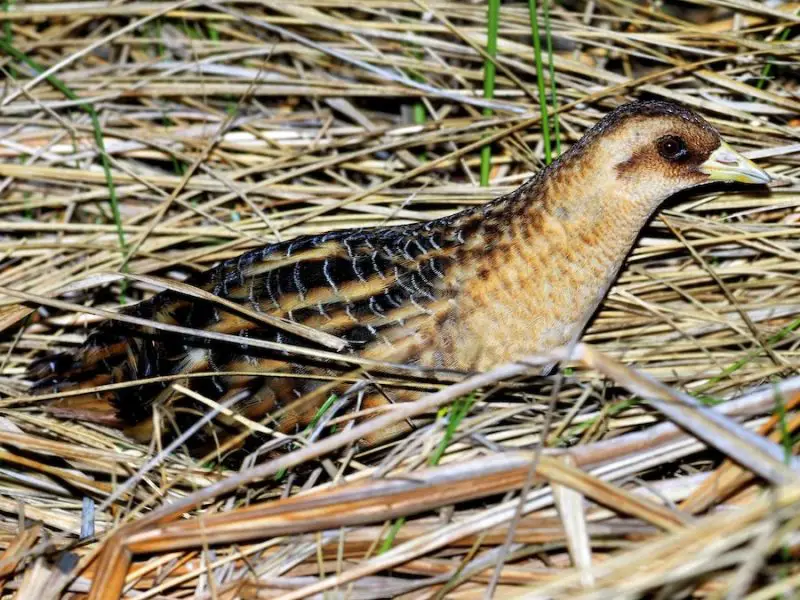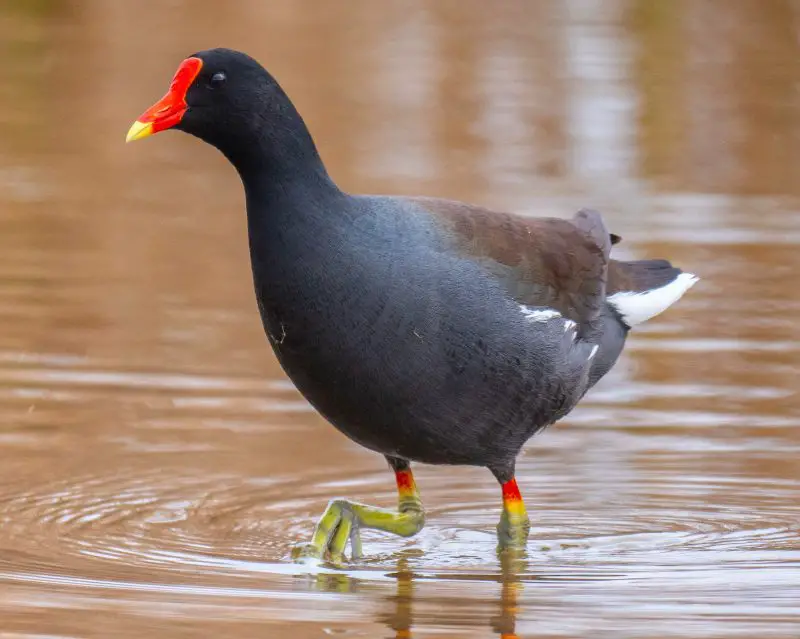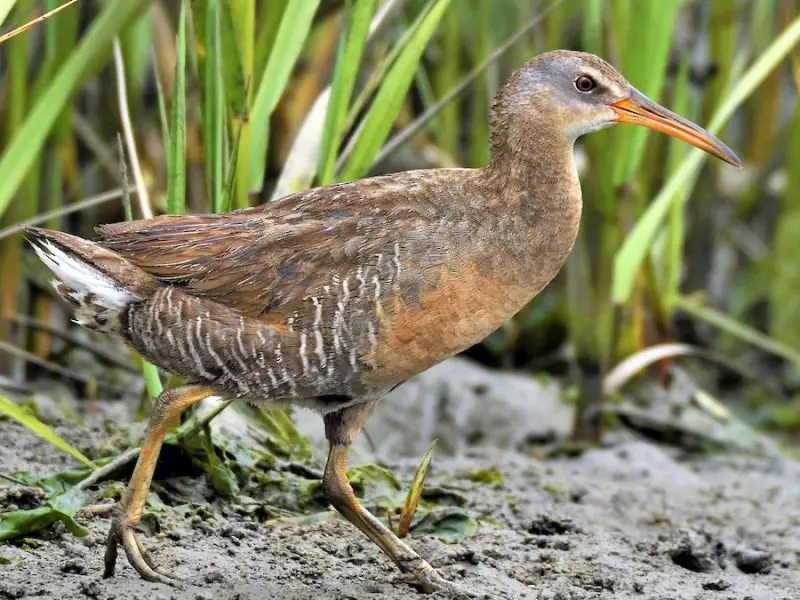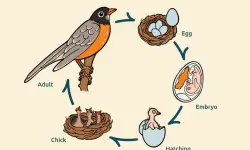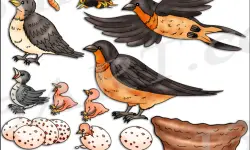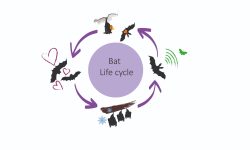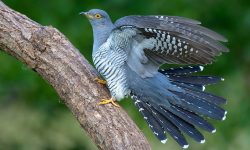Michigan’s vast wetlands, from inland marshes to Great Lakes shorelines, are home to a unique group of secretive birds known as rails. These elusive birds, along with their marsh-dwelling relatives, prefer dense reeds and shallow waters, making them challenging to observe yet fascinating to study. This guide explores 11 species of rails and marsh birds that have been recorded in Michigan, from the widespread American Coot to the rarely seen Yellow Rail.
What Are Rails and Marsh Birds?
Rails are part of the Rallidae family, which also includes gallinules, coots, and moorhens. They are known for their slender bodies, allowing them to slip easily through dense vegetation, and for their loud, often strange calls. Marsh birds, more broadly, include other water-loving species that live in similar wetland environments.
While some of these birds are residents or regular breeders in Michigan, others are migrants or accidental visitors.
1. Virginia Rail (Rallus limicola)
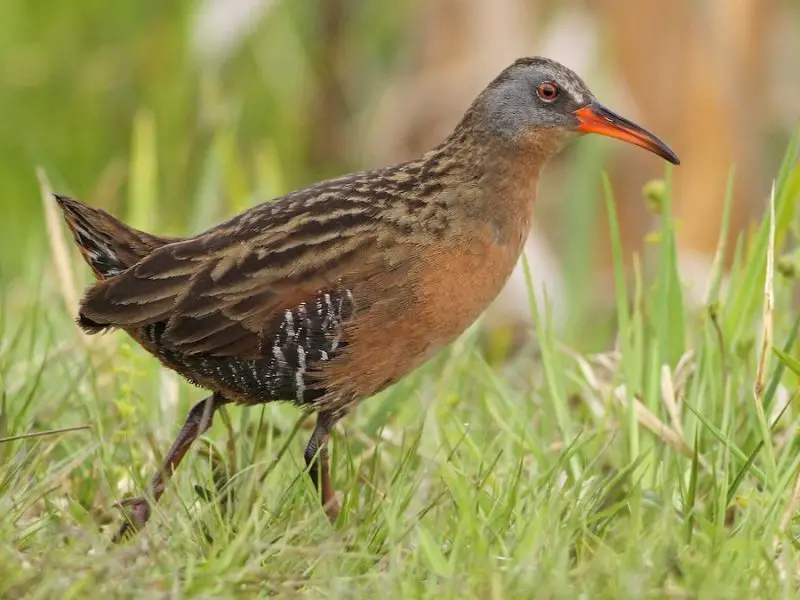
Status in Michigan
The Virginia Rail is a widespread and reliable breeder across southern and central Michigan, thriving in habitats like cattail marshes, wet meadows, and shallow sedge swamps. Despite their abundance, they remain one of the most elusive marsh birds in the state due to their secretive habits.
Identification
Small but full of character, the Virginia Rail sports gray cheeks, a warm cinnamon-brown body, and bold black-and-white streaking on the flanks. Its slender, slightly down-curved orange bill is perfectly suited for probing mud in search of prey. With short wings and a compact frame, it blends seamlessly into dense vegetation. While difficult to spot, its presence is often revealed by its unmistakable vocalization.
Behavior and Habitat
True to its rail reputation, the Virginia Rail is a master of camouflage, spending most of its life weaving through the bases of reeds, completely hidden from sight. It is most active at dawn and dusk, when it emerges briefly to forage for aquatic insects, small snails, crustaceans, and worms.
Instead of flying, it prefers to slip silently through thick vegetation, making only the faintest rustle. But its loud, distinctive call—a sharp, repeating “kiddick-kiddick-kiddick”—echoes across the marsh and is the best way to detect its presence. During breeding season, it also produces a low grunting series and a ticking sound that helps it stay in contact with its mate and chicks.
Virginia Rails build their nests in well-hidden spots just above the waterline, weaving a cup-shaped structure out of grasses and sedges. Their eggs are well camouflaged, and the downy chicks are precocial, able to follow their parents shortly after hatching.
In Summary
The Virginia Rail may be small and secretive, but it’s an essential part of Michigan’s wetland ecosystems. To spot one is a birder’s reward—an encounter with one of the marsh’s most mysterious residents.
2. Sora (Porzana carolina)
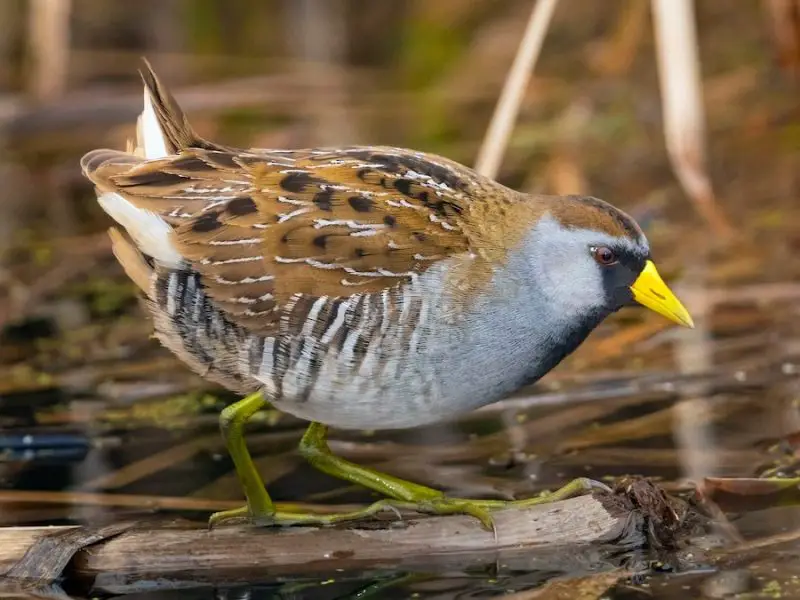
Status in Michigan
The Sora is one of Michigan’s most frequently encountered rail species, especially during the spring and summer breeding season. Found across a wide range of inland wetlands, from southern cattail marshes to northern sedge meadows, the Sora is a reliable inhabitant of the state’s freshwater marshes.
Identification
Although often hidden, the Sora is instantly recognizable if seen. It has a short, bright yellow bill, a distinctive black facial patch, and a warm brown body speckled with white streaks on the flanks. The undertail is notably short and often flicked while walking. Adults measure around 8–9 inches in length, and their compact build helps them navigate dense vegetation with ease.
But what truly sets the Sora apart is its unique vocalization—a high-pitched, descending “whinny” that sounds like a horse in miniature. This call is often the only indication that a Sora is nearby, especially during early morning or late evening hours.
Habitat and Behavior
Soras thrive in freshwater marshes with thick stands of emergent plants such as cattails, bulrushes, and sedges. These birds are well adapted to wet environments and use their long toes to walk atop floating vegetation with remarkable balance.
While generally shy and retiring, Soras are somewhat bolder than other rail species, occasionally venturing into more open areas at the edges of marshes while foraging. They feed on a varied diet that includes insects, spiders, aquatic snails, and seeds, especially from smartweed and sedges. This omnivorous behavior helps sustain them during their long migration and breeding season.
Nesting typically begins in late spring. Soras build their nests as platforms just above shallow water, carefully hidden among reeds. The female lays up to a dozen eggs, which hatch into black, downy chicks that can follow their parents within hours.
In Summary
The Sora is a charming and surprisingly vocal resident of Michigan’s wetlands, offering one of the best chances to hear—and possibly glimpse—a rail in the wild. Its eerie, horse-like call floating over a misty marsh is one of the signature sounds of spring in the Great Lakes region. Despite its elusive nature, the Sora stands as an iconic ambassador for healthy wetland ecosystems.
3. King Rail (Rallus elegans)
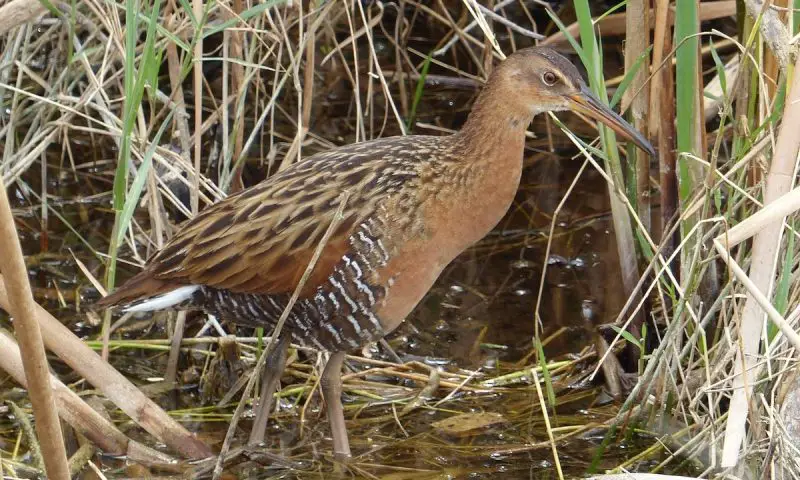
Status in Michigan
The King Rail is a rare and localized breeder in Michigan, primarily found in the southernmost portions of the state where extensive freshwater marshes still exist. Once more widespread, this species has suffered significant population declines in Michigan and across much of its northern range. Today, spotting a King Rail in the state is a special occasion for birders and conservationists alike.
Identification
True to its regal name, the King Rail is the largest rail species native to North America. It stands out with its rich reddish-brown breast, bold black-and-white barring on the flanks, and a long, slightly curved orange bill. Its upperparts are mottled brown with subtle streaking, providing excellent camouflage in marsh vegetation.
In size and structure, it is much larger than the more common Virginia Rail, with a length reaching up to 19 inches and a wingspan of nearly 20 inches. Though visually striking, King Rails remain elusive, preferring to move silently through dense cover.
Behavior and Habitat
King Rails favor large, undisturbed freshwater marshes with dense stands of cattails, reeds, or wild rice, often mixed with shallow pools or mudflats. Their diet is highly varied and includes aquatic insects, small crustaceans, frogs, and plant material. They use their long bills to probe soft mud for prey, often near the water’s edge.
These birds are most active at dawn and dusk, when they emit a series of loud, grunting calls and clicking sequences that can travel long distances through the marsh. Despite their vocal nature, actual sightings remain rare due to their highly secretive behavior.
During breeding season, King Rails construct well-hidden nests above shallow water, often supported by thick vegetation. Chicks hatch precocial and quickly learn to follow their parents through the tangled wetland underbrush.
Conservation Note
The King Rail is currently listed as a species of conservation concern in Michigan and several other Great Lakes states. Its numbers have declined due to wetland loss, habitat fragmentation, pollution, and encroachment by invasive species. Because they require large, intact marshes to survive, their presence serves as an important indicator of wetland ecosystem health.
Conservation efforts focused on wetland restoration, protection of breeding sites, and water level management are critical to the survival of this majestic bird in the region.
In Summary
The King Rail represents one of the rarest and most elusive marsh birds in Michigan. With its striking coloration and preference for pristine wetlands, it symbolizes both the beauty and fragility of these disappearing ecosystems. For those lucky enough to hear its deep, echoing calls or catch a glimpse of it moving like a shadow through the reeds, the experience is unforgettable.
5. Black Rail (Laterallus jamaicensis)
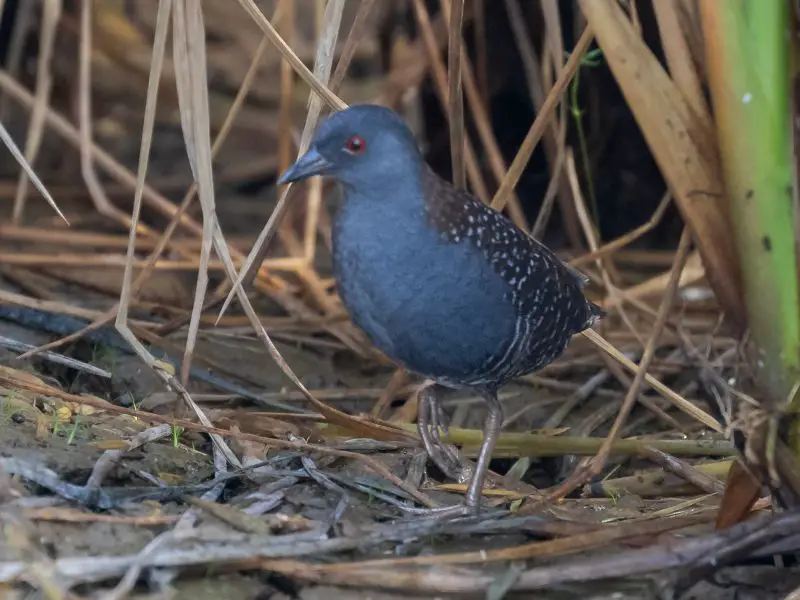
Status in Michigan
The Black Rail is considered an accidental visitor in Michigan, with only a handful of documented sightings—almost all involving migratory strays. This tiny, nocturnal rail is so rarely detected in the Great Lakes region that any report generates excitement among ornithologists and birders alike. There is no confirmed evidence of breeding in Michigan, and sightings remain extraordinarily scarce.
Identification
As one of the smallest rail species in North America, the Black Rail measures just 4 to 6 inches long, about the size of a sparrow, making it incredibly difficult to observe even under ideal conditions. It has a compact, rounded body, short tail, and short bill.
Its plumage is dark gray to charcoal black, sometimes with a brownish wash on the upperparts. The sides are marked with small white speckles, and the eyes are a vivid ruby red, creating a dramatic contrast. Its overall appearance is dense and shadowy, perfectly suited for blending into low, soggy marsh vegetation.
Vocalizations and Behavior
Black Rails are far more likely to be heard than seen, particularly during spring and early summer nights. Their most distinctive call is a two-note “kickee-doo” or “ki-ki-krr,” often repeated rhythmically in the darkness.
This species is extremely secretive and sedentary, spending nearly all its time beneath dense grass or saltmarsh vegetation. Even when flushed, it tends to run instead of fly, making it nearly invisible. It prefers to forage on foot, picking up tiny insects, seeds, and invertebrates close to the ground or in shallow water.
Because of its secretive nature, it is one of the least understood birds in North America, and many aspects of its life cycle remain hidden to science.
Conservation Status
The Black Rail is critically imperiled across much of its historical range. It is currently listed as Threatened under the U.S. Endangered Species Act, with fewer than a few hundred known breeding pairs nationwide. Major declines have been driven by the loss and degradation of shallow, wet grassland habitats, sea-level rise, invasive plants, and human encroachment.
In Michigan, habitat conditions are generally unsuitable for breeding, and the species is considered a rare vagrant rather than part of the state’s regular bird community.
In Summary
The Black Rail is a ghost of the marsh—tiny, secretive, and vanishingly rare. While its presence in Michigan is mostly the result of accidental migration, every sighting underscores the urgent need to protect the disappearing wetland habitats that these birds rely on. Its haunting call in the night remains one of the most coveted experiences in North American birding, and a potent symbol of the fragility of marshland ecosystems.
7. American Coot (Fulica americana)
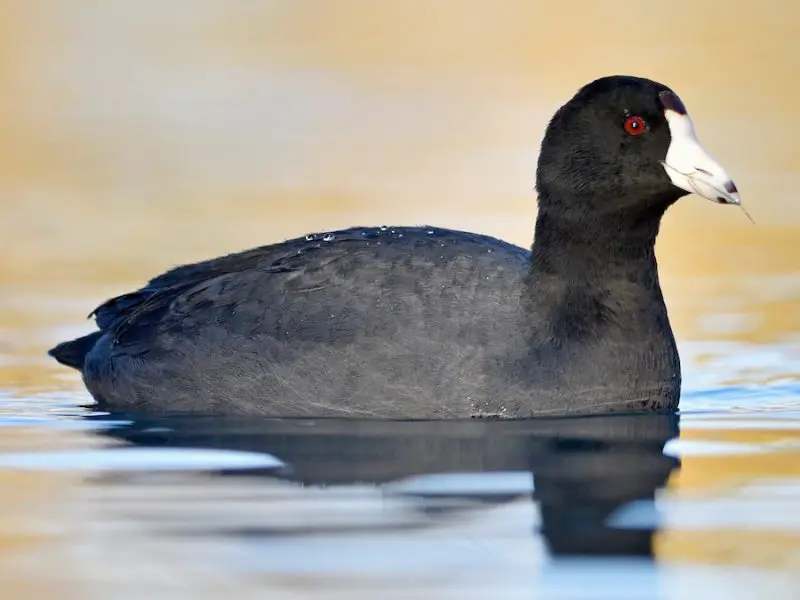
Status in Michigan
The American Coot is one of the most common and widespread marsh birds in Michigan, seen in large numbers during spring and fall migration, and regularly breeding throughout the summer. From the southern marshes to the northern lakeshores, coots are a familiar sight on virtually any body of water across the state.
Identification
At first glance, the American Coot might be mistaken for a duck, but a closer look reveals key differences. It has a dark gray to blackish body, a snow-white bill, and vivid red eyes. The head is rounded and often appears tucked slightly downward while swimming.
Unlike ducks, coots lack webbed feet—instead, they have lobed toes, which help them move efficiently through water and across floating vegetation. Their unique leg structure also allows them to walk surprisingly well on land.
In flight, American Coots are heavy and awkward, often requiring a long, splashing takeoff across the water’s surface.
Habitat and Diet
American Coots are highly adaptable and can be found in a variety of freshwater habitats including ponds, lakes, slow-moving rivers, reservoirs, and marshes. They prefer areas with both open water and aquatic vegetation, which provide feeding grounds and nesting cover.
They are omnivorous foragers, feeding on a diverse menu that includes aquatic plants, duckweed, algae, grasses, seeds, snails, and small aquatic insects. Coots dive underwater or tip forward like ducks to reach submerged vegetation, and they will also graze near the shore.
During migration, they often gather in massive flocks, sometimes numbering in the hundreds or even thousands, creating a noisy and bustling scene on inland lakes and wetlands.
Behavior and Nesting
Despite their duck-like habits, coots are more closely related to rails and gallinules. They are strong swimmers and frequently seen paddling through open water, but they also walk on land and climb into emergent vegetation.
Coots are social birds and often nest in colonies, especially in wetlands with dense vegetation. Nests are built as floating platforms hidden among reeds or bulrushes. Both parents incubate the eggs and tend to the chicks, which are highly precocial—able to swim and follow their parents shortly after hatching.
Their vocalizations include a wide variety of grunts, clucks, and squeaks, often used to communicate in noisy flocks or during territorial disputes.
In Summary
The American Coot may not be as flashy as some waterbirds, but it is a versatile, resilient, and essential member of Michigan’s wetland communities. Whether swimming in a quiet pond or foraging in a noisy flock, coots are a reminder of how life thrives at the intersection of land and water. For birders, they offer both a common companion and an ecological indicator of wetland health across the state.
8. Purple Gallinule (Porphyrio martinicus)
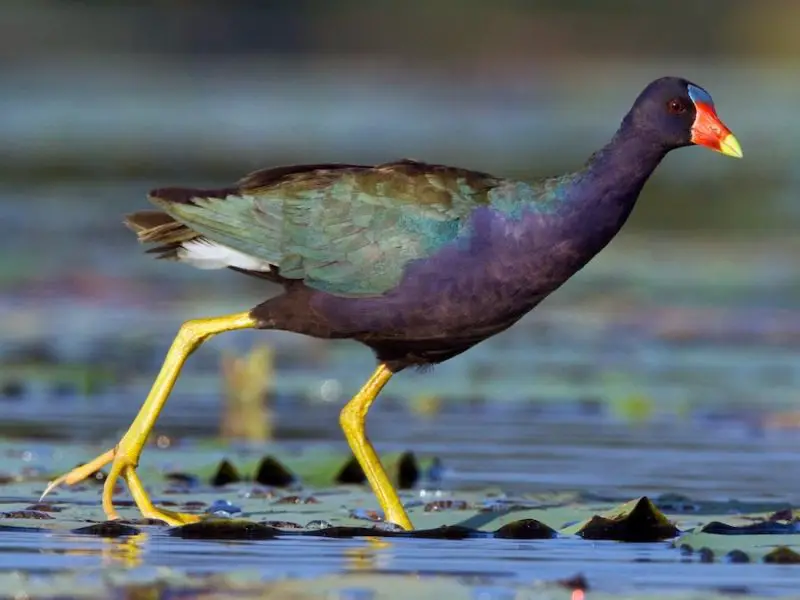
Status in Michigan
The Purple Gallinule is a rare and unexpected visitor to Michigan. Native to the southeastern United States, particularly the Gulf Coast and Florida wetlands, this brilliantly colored bird occasionally strays far beyond its normal range. In Michigan, it is classified as a vagrant, with only a handful of documented records, typically involving lost individuals during spring or fall migration.
Though not a regular resident, the appearance of a Purple Gallinule in Michigan is a thrilling event for birders, often prompting statewide alerts.
Identification
Few birds are as visually striking as the Purple Gallinule. Its iridescent plumage glows with shades of deep purple, royal blue, and emerald green, making it look almost tropical—more at home in a rainforest than a Midwestern marsh.
It has a bold red bill with a yellow tip, a sky-blue frontal shield, and bright yellow legs and feet that are disproportionately long, enabling it to walk across floating vegetation like lily pads. Measuring about 10 to 12 inches in length, it resembles a Common Gallinule in structure but is more colorful and exotic in appearance.
Juveniles are brown and tan, gradually acquiring the adult’s brilliant colors with age.
Behavior and Habitat
In its home range, the Purple Gallinule is most often found in warm, freshwater marshes, ponds, and swamps with abundant floating plants. It feeds on a wide range of foods, including aquatic insects, snails, small fish, seeds, and fruits, and uses its long toes to balance nimbly as it forages among lily pads and emergent vegetation.
Although it is an excellent swimmer, it prefers to walk delicately across vegetation, picking food from the water’s surface or plucking berries from overhanging plants.
In Michigan, any individual that appears is usually a wandering migrant blown off course, often seen near coastal marshes, inland lakes, or urban wetlands. These birds rarely remain for long and are considered exceptional sightings.
Occurrence in Michigan
Confirmed records are few, and most involve solitary individuals spotted in late spring or early fall. These rare appearances may result from weather-related disorientation, habitat misselection, or natural exploratory behavior during migration.
Because of their vivid coloration and rarity in the state, Purple Gallinules almost always attract attention when they do appear, drawing birders from far and wide.
In Summary
With its dazzling plumage and delicate movements, the Purple Gallinule is one of the most visually stunning marsh birds to ever grace Michigan’s wetlands—if only briefly. Though not part of the state’s regular avifauna, its rare appearances offer a magical reminder of the unpredictability of bird migration, and the astonishing diversity that may be hiding just beyond the reeds.
10. Purple Swamphen (Porphyrio porphyrio)
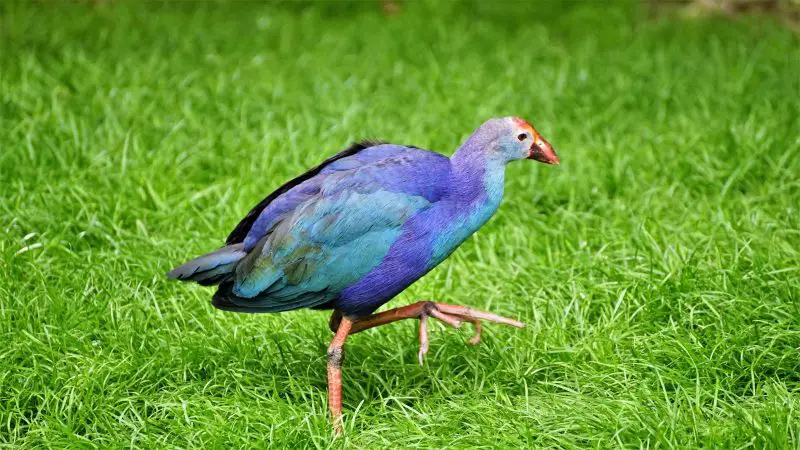
Status in Michigan
The Purple Swamphen is considered an exotic escapee in Michigan, occasionally appearing near urban wetland parks, ornamental ponds, or managed wildlife areas. These sightings are extremely rare and not part of the state’s native avifauna. Individuals reported in Michigan are believed to originate from captive populations, or more likely, from established feral populations in Florida that have expanded beyond their expected range.
Although not officially recognized as part of the state’s breeding birds, the presence of Purple Swamphens adds an unexpected and exotic flair to Michigan bird lists.
Origin and Background
The Purple Swamphen is native to a wide geographic range spanning southern Europe, Africa, the Middle East, the Indian subcontinent, and Southeast Asia. Over the past few decades, it has been introduced—intentionally or accidentally—into new environments, most notably in south Florida, where it has established small but persistent breeding populations.
In the U.S., the species was first observed in the wild in Florida in the late 1990s, likely from escapes from zoos, aviaries, or private collections. Despite some early eradication efforts, the swamphens adapted quickly and have since spread through southern wetlands. From there, a few wandering or displaced individuals have made it as far north as the Midwest, including rare sightings in Michigan.
Identification
The Purple Swamphen is an impressively large, vibrant marsh bird, easily recognized by its striking appearance. Adults are covered in rich purplish-blue plumage with a turquoise sheen, a bright red bill and frontal shield, and long, coral-red legs. They are larger and bulkier than Common Gallinules, with a stocky build and upright posture.
One of their most distinctive features is their enormous feet, with long toes designed for grasping vegetation and walking across floating plants. In flight, their wings are broad and rounded, and they appear slow and heavy in the air.
Juveniles are duller in color, with more brownish tones and reduced facial markings.
Behavior and Habitat
In regions where they are established, Purple Swamphens prefer shallow, vegetated freshwater wetlands, including marshes, canals, flooded fields, and ornamental lakes. They are omnivorous, feeding on aquatic plants, shoots, small animals, snails, eggs, and carrion. They often tear vegetation apart with their strong bills and use their feet to manipulate food, much like parrots.
They are confident walkers, often seen striding through reeds or along pond edges. Though capable of swimming, they prefer to stay on floating platforms or mudflats.
In Michigan, any sightings likely occur near urban or suburban wetlands where exotic birds may find suitable refuge or escape from captivity. There is no evidence of breeding in the state, and most individuals do not survive the harsh northern winters.
In Summary
The Purple Swamphen is an unexpected splash of tropical color in Michigan’s marshes, representing the rare intersection between the wild and the ornamental. Though not a native species, its occasional appearances remind us of how bird ranges are shifting—sometimes due to climate, sometimes due to human activity. Whether glimpsed walking confidently through lily pads or flashing iridescent wings in flight, this charismatic intruder leaves a lasting impression on anyone lucky enough to see it.
11. Eurasian Coot (Fulica atra)
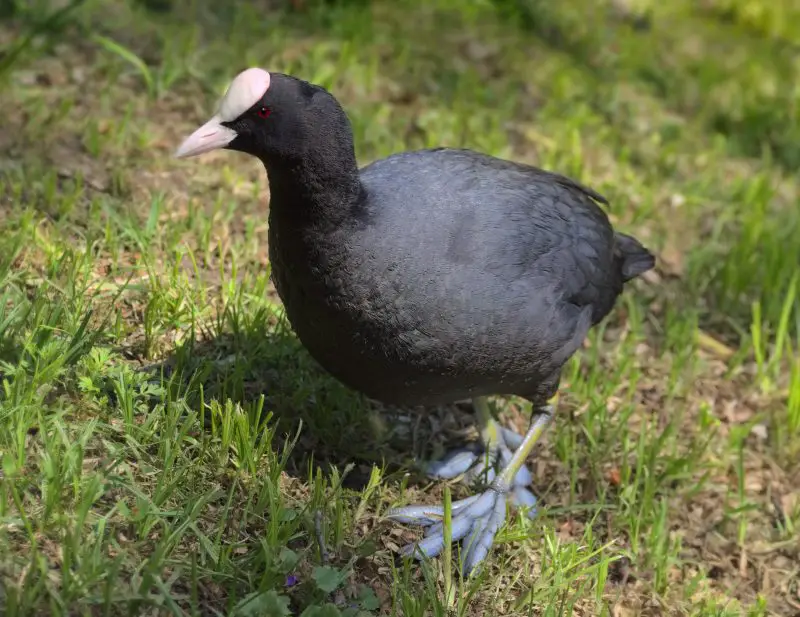
Status in Michigan
The Eurasian Coot is an extremely rare vagrant in Michigan, with only a few confirmed sightings in the state’s ornithological records. Native to Europe, Asia, and parts of North Africa, this species occasionally reaches North America, typically during unusual migration events or storm-assisted transatlantic flights. In Michigan, any appearance is a remarkable and highly notable event for local birders and ornithologists.
Most sightings in North America occur along the East Coast or in Alaska; in the Great Lakes region, the Eurasian Coot remains an exceptional rarity.
Identification
At first glance, the Eurasian Coot looks nearly identical to its North American cousin, the American Coot. However, subtle distinctions set it apart upon closer inspection. It has slate-black plumage, a pure white bill, and a larger, more pronounced white facial shield that extends further up the forehead. The body shape is slightly more compact, and its posture while swimming can appear more upright.
Unlike the red-eyed American Coot, the Eurasian Coot’s iris is a dark reddish-brown, which may be difficult to see in the field. The vocalizations also differ: the Eurasian Coot emits harsher, croaking calls and shrill, squeaky notes compared to the more nasal and clucking calls of the American Coot.
Because of their resemblance, identifying a Eurasian Coot in North America requires high-quality photographs or detailed observation, often confirmed through plumage, call, and behavior.
Behavior and Habitat
The Eurasian Coot shares much of the same behavior as the American species. It is a strong swimmer, often seen paddling in open water or walking along muddy shorelines. Its diet includes aquatic vegetation, algae, small invertebrates, and seeds. Like its counterpart, it also has lobed toes rather than webbed feet, enabling it to forage across floating plants or wade through dense aquatic growth.
In its native range, it breeds in freshwater lakes, ponds, and marshes, often forming noisy colonies. During winter, it migrates to larger bodies of water, including estuaries and coastal lagoons.
In Michigan, the species has no breeding population and any individuals present are likely solitary wanderers, often appearing alongside American Coots during fall migration or early spring.
In Summary
The Eurasian Coot is an unusual and exciting visitor to Michigan’s birding scene—a transatlantic drifter whose presence stirs curiosity and excitement among experts. Nearly identical to the American Coot but with subtle plumage and vocal differences, its rare appearance offers a unique challenge for bird identification and a reminder of the global scale of bird migration. For those fortunate enough to document one, it’s a feathered gem from across the ocean.
Where and When to Spot Rails in Michigan
Best Habitats
If you’re hoping to catch a glimpse of these secretive birds, visit:
-
Shiawassee National Wildlife Refuge
-
Pointe Mouillee State Game Area
-
Seney National Wildlife Refuge
-
Kensington Metropark (especially for coots and gallinules)
-
Northern bogs and fens for rare species like Yellow Rail
Prime Seasons
-
Spring and fall are best for migration sightings
-
Late May to early July is ideal for breeding birds
-
Dawn and dusk offer the best chance to hear rail vocalizations
Final Thoughts: A Hidden World in the Reeds
Rails and their marsh relatives may not be as flashy as warblers or raptors, but their elusive nature makes every sighting special. Whether you’re a seasoned birder or a curious explorer, Michigan’s wetlands hold a rich diversity of rail species worth discovering. Bring a sharp ear, a quiet step, and perhaps a little luck—you never know what might be calling from the reeds.

